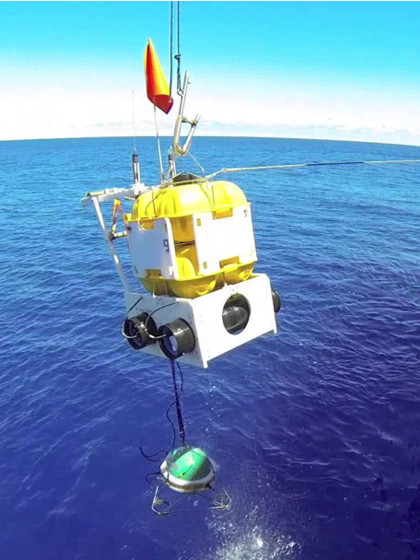
by Izze Siemann Tuesday, April 3, 2018

An ocean-bottom seismometer is deployed in the Indian Ocean. Credit: RHUM-RUM experiment/Meteor Cruise
Lapping waves or crashing surf may come to mind for most people when they imagine the sounds of the ocean. But the ocean has other voices as well, including one produced by interactions of waves with the seafloor along the continental slope. Unlike waves on the shoreline, this steady, low sound, or “hum,” is inaudible to the human ear and has even proven difficult to detect in recordings made by ocean bottom seismometers (OBS). But in a new study in Geophysical Research Letters, researchers analyzing OBS data have now clearly identified the hum for the first time, which may allow it to be used to develop a better picture of Earth’s interior structure.
The hum, first hypothesized in 1959 by seismologist Hugo Benioff and his colleagues, consists of low-frequency vibrations — akin to earthquakes but much weaker — that constantly move through Earth. The sound was first detected in 1998 in data from a gravimeter station in Antarctica, and subsequently with land-based seismometers. But its detection in OBS data is complicated because of the large amount of seismic noise at the ocean bottom.
In the new study, Martha Deen, a doctoral candidate at the Paris Institute of Earth Physics in France, and colleagues — including Erhard Wielandt, Eleonore Stutzmann, Wayne Crawford, Guilhem Barruol and Karin Sigloch — used OBS data from seismometers previously deployed as part of the RHUM-RUM project near Réunion Island in the Indian Ocean. Even with these highly sensitive seismometers, deciphering the recorded data “was quite a challenge, because a high-quality seismometer, similar to the ones used on land, records much more noise when it is installed at the seafloor,” Deen says. Not only did the seismometers record the hum, but also the noise of ocean currents surrounding the station.
Another challenge the researchers faced with the data came from consistent electronic glitches produced by the seismometers during signal transmissions, which added more error into the OBS data. Removing these glitches from the data “was necessary because some of its signal is at similar frequencies as the hum, and at much higher amplitude,” Deen says. “Imagine a choir: The loudest voice makes it difficult to distinguish a [quieter] singer, more so if the quiet singer has the same tone of voice.”
Deen and her colleagues, using various data processing techniques, were able to isolate and subtract the various noise sources from the raw seismic data, leaving behind just the hum.
Understanding, and being able to access, Earth’s humming vibrations could enrich many fields of study, the team wrote in the study. For example, in tomography, scientists use seismic waves, typically from earthquakes, to map the structure of Earth’s interior. Signals from large earthquakes offer greater sensitivity in imaging the subsurface and “are more useful,” says Spahr Webb, a geophysicist at Columbia University’s Lamont-Doherty Earth Observatory who works with OBS data to study subduction zones.
But unlike earthquakes, Earth’s hum occurs throughout large portions of the planet and is a constant source of seismicity, making it ideal for tomographic studies. “To get a good [tomographic] image, ideally these [seismic] recordings should be from places covering the entire surface of the globe,” Deen says. Much of Earth is covered by oceans, so land-based seismic stations alone leave large parts of the planet unrepresented, she says. “Including OBS stations would help increase data coverage, possibly [improving] the imaging, and with it the understanding of the Earth’s interior.” Deen says she hopes more ocean bottom stations will be deployed in the future.
Researchers can also use the hum signal to study more about the ocean itself, including the wave-generated origins of the hum as well as how the ocean is changing over time. Future work will benefit from understanding the process generating the signals, Webb says.
Deen says the research into Earth’s hum is ongoing and that a next step is to improve “the understanding of the lateral and temporal variation of the hum signal and its generation,” including whether latitude affects these processes.
© 2008-2021. All rights reserved. Any copying, redistribution or retransmission of any of the contents of this service without the expressed written permission of the American Geosciences Institute is expressly prohibited. Click here for all copyright requests.